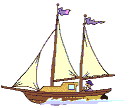 A
BRIEF BIOGRAPHICAL SKETCH OF
A
BRIEF BIOGRAPHICAL SKETCH OF A
BRIEF BIOGRAPHICAL SKETCH OF
A
BRIEF BIOGRAPHICAL SKETCH OF
PETER GEORGE JACOBSEN
Since the subject of this sketch is intimately connected with the origin and history of the Crucifix which he brought from a foreign land to America, it is but natural that a few references to the biography of this pioneer and contender for the Lutheran doctrine and faith be made before proceeding to record the information concerning the origin of this particular Crucifix.
Peter George Jacobsen, a native of Flensburg, Germany, and born of Christian parents, decided to study for and enter the holy ministry. He attended the University of Berlin during the years between 1850 and 1855, graduating from that institution in the department of theology, upon which he entered the University of Copenhagen where he completed a three years’ course in medicine. Commissioned by a duly authorized Mission Board in Germany, he left Bremerhafen about the year 1860 upon a sailing vessel for Australia. Had it not been for the Civil War then raging in the United States he would undoubtedly have been sent to America, so he revealed to me. The voyage to Australia in those days must have been a venture of faith. With him he took quite a library of Luther’s Works (Erlanger-Ausgabe), and other writings of the theologians of his time. The voyage of a sailing vessel required over somewhat three months to South Australia, and for many days the crew and passengers subsisted on hardtack and water.
On arriving in the province of Victoria, he was assigned to about seven congregations, three, which were located in Minyep, Horsham and Mortua. Being quite a linguist especially in the Scandinavian languages he was also given charge over a field in the region of the castlemane Silver Mines in which field he preached to the Danish miners. And it was here that history records the origin of our Crucifix. The Danish miners whom he served in this community did not pay Pastor Jacobsen in the coin of the realm, but instead substituted silver bullion, and forthwith Pastor Jacobsen determined that with the bullion he would have cast – a Crucifix. It is hardly necessary at this juncture to add that the craftsman of that day and age must have understood the art of casting; but we shall leave that decision to those critics who will have the opportunity to see the Crucifix in our Historical Institute.
Needless to say, Pastor Jacobsen placed the Crucifix upon the altars of his various parishes, and especially so when the Lord’s Supper was being celebrated. But this Crucifix occupied not only altars in Australia, but also in Christchurch located in the province of Canterbury on the South Island. Then, too, it accompanied my sainted father to California in the year 1884 where it had many opportunities to be viewed by the faithful. And last but not least, our Crucifix had often graced the altar of the chapel in our Danish old peoples’ Home here in San Rafael where the Rev. John Jacobsen, my oldest son, officiated along with serving the local congregation, but who later accepted a call to San Diego, whereupon the Rev. Frank Jacobsen, now stationed in San Francisco, assumed the duties as Chaplain in addition to his many official duties in his district and San Francisco parish.
And it was during his tenure of office that the two grandsons of Peter George Jacobsen were allowed to experience the honor and thrill of making use of that Crucifix for which the Danish miners in distant Castlemane furnished the silver bullion 100 years ago!
And so we conclude the saga of our Australian Crucifix with the hope that it will prove to be a worthy contribution to the many museum pieces already installed in the Waltke Museum Room of our esteemed Historical Institute.
Rev. Geo. C. Jacobsen
January, 1963